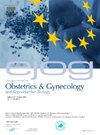妊娠期阻塞性睡眠呼吸暂停:全国产科特征和分娩时产妇发病率评估。
IF 1.9
4区 医学
Q2 OBSTETRICS & GYNECOLOGY
European journal of obstetrics, gynecology, and reproductive biology
Pub Date : 2025-10-03
DOI:10.1016/j.ejogrb.2025.114753
引用次数: 0
摘要
目的:阻塞性睡眠呼吸暂停(OSA)与普通人群的心血管、代谢和精神疾病有关。对妊娠期阻塞性睡眠呼吸暂停的重要性了解较少。本研究的目的是在全国范围内评估与妊娠期呼吸暂停相关的产科特征和产妇发病率。方法:本横断面研究询问了美国医疗成本和利用项目的全国住院病人样本。研究人群为2016年至2020年期间在医院分娩的18056390人。OSA采用国际疾病分类第十版临床修改代码G47.33 (n = 22,360)进行鉴定。根据疾病控制和预防中心定义的严重孕产妇发病率在基于孕前特征的n对1倾向评分匹配队列中进行评估,随后在二元logistic回归模型中调整妊娠混杂因素。使用分类树模型评估与OSA相关的临床人口学模式。结果:妊娠期OSA患者的编码患病率为12.4 / 10,000,在5年期间从8.5 / 10,000增加到16.6 / 10,000 (p趋势)结论:美国同期的全国评估表明,诊断代码为OSA的妊娠患者是一个高危人群,与分娩时呼吸和心脏疾病有关。尽管这项研究受限于对行政编码的依赖,但这些结果是重要的,并表明需要在高危人群中进行积极的OSA筛查。本文章由计算机程序翻译,如有差异,请以英文原文为准。
Obstructive sleep apnea in pregnancy: Nationwide assessment of obstetric characteristics and maternal morbidity at delivery
Objective
Obstructive sleep apnea (OSA) is associated with cardiovascular, metabolic, and psychiatric conditions in the general population. Less is known about the significance of OSA during pregnancy. The objective of this study was to assess the obstetric characteristics and maternal morbidity associated with OSA during pregnancy at a national scale.
Methods
This cross-sectional study queried the Healthcare Cost and Utilization Project’s National Inpatient Sample in the United States of America. The study population was 18,056,390 hospital deliveries from 2016 to 2020. OSA was identified using the International Classification of Disease Tenth Revision Clinical Modification code G47.33 (n = 22,360). Severe maternal morbidity per the Centers for Disease Control and Prevention definitions was assessed in an N-to-1 propensity score-matched cohort based on pre-pregnant characteristics followed by adjustment for pregnancy confounders in a binary logistic regression model. Patterns of clinical demographics related to OSA were assessed with a classification-tree model.
Results
The coded prevalence of pregnant patients with OSA was 12.4 per 10,000, which increased from 8.5 to 16.6 over a 5-year period (P-trend < 0.001). Patients with OSA were more likely to have a diagnosis of obesity (69.7 % vs 11.4 %, adjusted-odds ratio [aOR] 9.97, 95 % confidence interval [CI] 9.67–10.28), asthma (28.0 % vs 5.2 %, aOR 3.19, 95%CI 3.09–3.29), pre-gestational hypertension (24.8 % vs 2.8 %, aOR 2.77, 95%CI 2.68–2.87), and polycystic ovary syndrome (5.6 % vs 0.7 %, aOR 2.58, 95%CI 2.42–2.74). In the classification-tree model, the coded prevalence rate of OSA increased to 571.4 per 10,000 among pregnant patients with obesity, asthma, and pre-gestational hypertension. In the matched cohort, pregnancy with OSA was associated with gestational hypertension (11.4 % vs 8.7 %, aOR 1.47, 95%CI 1.38–1.57), pre-eclampsia (28.2 % vs 14.7 %, aOR 1.92, 95%CI 1.82–2.02), gestational diabetes (20.1 % vs 13.9 %, aOR 1.45, 95%CI 1.38–1.53), placenta accreta spectrum (0.6 % vs 0.2 %, aOR 1.94, 95%CI 1.35–2.79), extreme preterm delivery (26–33 weeks, 9.3 % vs 4.9 %, aOR 1.53, 95%CI 1.41–1.67), and cesarean delivery (62.3 % vs 50.4 %, aOR 1.42, 95%CI 1.37–1.48). The odds of severe maternal morbidity at delivery was increased in pregnant patients with OSA (6.7 % vs 1.9 %, aOR 2.51, 95%Cl 2.24–2.81), particularly for respiratory morbidity indicators including maternal ventilation (0.8 % vs < 0.1 %, aOR 7.25, 95%CI 4.54–11.56), acute respiratory distress syndrome (2.3 % vs 0.3 %, aOR 4.97, 95%CI 3.88–6.36), and pulmonary edema including acute heart failure (2.0 % vs 0.4 %, aOR 4.06, 95%CI 3.19–5.18). In addition, the odds of peripartum cardiomyopathy increased by nearly seven-fold for the OSA vs non-OSA group (0.6 % vs < 0.1 %, aOR 6.62, 95%CI 3.86–11.36).
Conclusions
This contemporaneous nationwide assessment in the United States suggests that pregnant patients with a diagnosis code of OSA represent a high-risk group that is associated with respiratory and cardiac morbidity at delivery. Although this study is limited by reliance on administrative coding, these results are significant and demonstrate a need for aggressive OSA screening in at-risk groups.
求助全文
通过发布文献求助,成功后即可免费获取论文全文。
去求助
来源期刊
CiteScore
4.60
自引率
3.80%
发文量
898
审稿时长
8.3 weeks
期刊介绍:
The European Journal of Obstetrics & Gynecology and Reproductive Biology is the leading general clinical journal covering the continent. It publishes peer reviewed original research articles, as well as a wide range of news, book reviews, biographical, historical and educational articles and a lively correspondence section. Fields covered include obstetrics, prenatal diagnosis, maternal-fetal medicine, perinatology, general gynecology, gynecologic oncology, uro-gynecology, reproductive medicine, infertility, reproductive endocrinology, sexual medicine and reproductive ethics. The European Journal of Obstetrics & Gynecology and Reproductive Biology provides a forum for scientific and clinical professional communication in obstetrics and gynecology throughout Europe and the world.

 求助内容:
求助内容: 应助结果提醒方式:
应助结果提醒方式:


